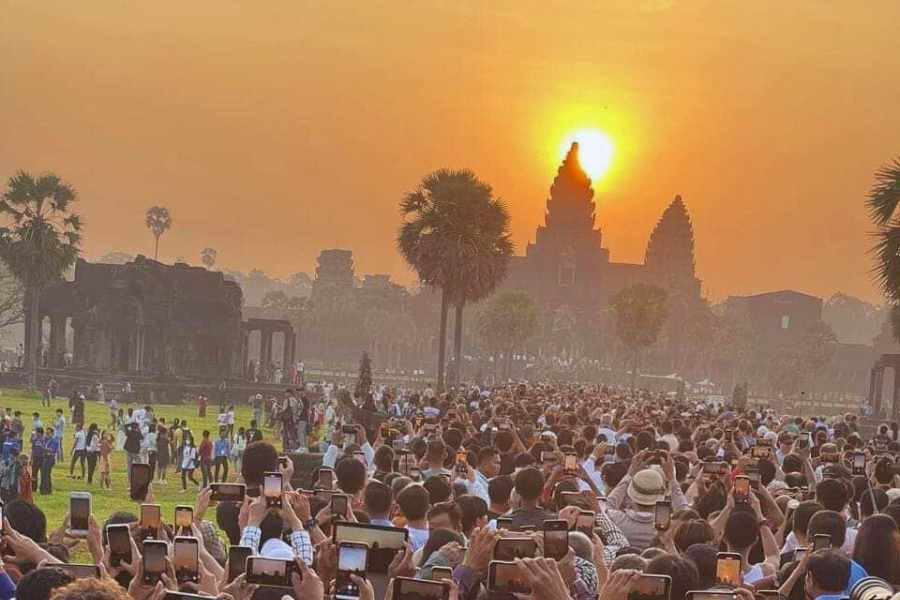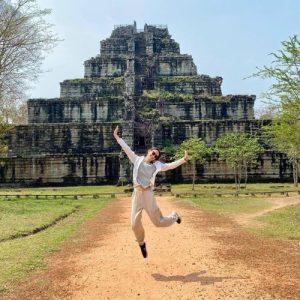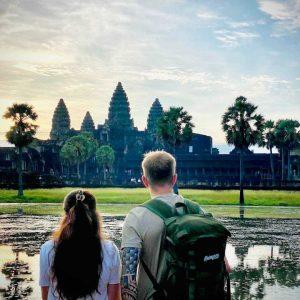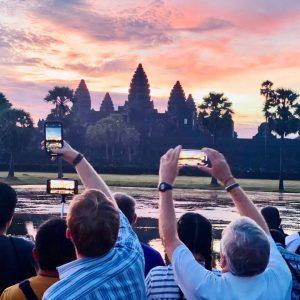The Fascinating Alignment of Angkor Wat
August 21, 2023

Table of Contents
The Fascinating Alignment of Angkor Wat
The Fascinating Alignment of Angkor Wat
Angkor Wat, the largest religious monument in the world located in Siem Reap, Cambodia, features a fascinating solar alignment that occurs twice a year during the equinoxes in March and September. This alignment of Angkor Wat is a mesmerizing phenomenon that attracts thousands of visitors each year. In this post, we will explore the history, architecture, and significance behind the alignment of Angkor Wat.
An Introduction to the Alignment of Angkor Wat
The alignment of Angkor Wat refers to the precise solar alignment where the sun rises directly behind the central tower of Angkor Wat during the equinoxes, creating a dramatic sight. This solar phenomenon happens twice a year in March and September.
The equinox sunrise aligns perfectly with the western entrance bridge of the 12th century Hindu temple, which was dedicated to the god Vishnu. As the sun rises over the horizon, its light projects a long shadow from the central tower that lines up precisely with the causeway entrance. Visitors can stand at the end of the causeway and watch as the sunrise creates this alignment of Angkor Wat.
When Does the Alignment Occur?
The alignment of Angkor Wat occurs on the two equinox days in March and September each year. The equinox refers to the two days of the year when the sun is directly above the equator, making the length of day and night equal.
The March or spring equinox happens around March 20th or 21st, while the September or fall equinox takes place around September 22nd or 23rd. On these special days, the sunrise will align directly with the center tower of Angkor Wat if viewed from the western entrance.
Alignment of Angkor Wat – Upcoming Equinox and Solstice Dates at Angkor Wat:
| Year | Spring Equinox | Summer Solstice | Fall Equinox | Winter Solstice |
|---|---|---|---|---|
| 2023 | Jun 21 21:57 ICT | Sep 23 13:49 ICT | Dec 22 10:27 ICT | |
| 2024 | Mar 20 10:06 ICT | Jun 21 03:50 ICT | Sep 22 19:43 ICT | Dec 21 16:20 ICT |
| 2025 | Mar 20 16:01 ICT | Jun 21 09:42 ICT | Sep 23 01:19 ICT | Dec 21 22:02 ICT |
| 2026 | Mar 20 21:45 ICT | Jun 21 15:24 ICT | Sep 23 07:05 ICT | Dec 22 03:49 ICT |
| 2027 | Mar 21 03:24 ICT | Jun 21 21:10 ICT | Sep 23 13:01 ICT | Dec 22 09:42 ICT |
| 2028 | Mar 20 09:16 ICT | Jun 21 03:01 ICT | Sep 22 18:44 ICT | Dec 21 15:19 ICT |
| 2029 | Mar 20 15:01 ICT | Jun 21 08:48 ICT | Sep 23 00:37 ICT | Dec 21 21:14 ICT |
| 2030 | Mar 20 20:51 ICT | Jun 21 14:31 ICT | Sep 23 06:26 ICT | Dec 22 03:09 ICT |
This table provides the dates and times of both the equinox and solstice alignments at Angkor Wat over the next years. Visitors planning a trip to see these events can use the schedules to pick their ideal date. The alignment of Angkor Wat will continue to occur predictably based on the astronomical calendar far into the future.
The History Behind the Temple’s Construction
To understand the alignment of Angkor Wat, we must first learn about the history of its construction. Angkor Wat was built in the early 12th century by King Suryavarman II as a Hindu temple dedicated to Vishnu, one of the principal deities in the Hindu pantheon.
Suryavarman II reigned over the powerful Khmer Empire from 1113-1150 AD. The king commissioned the construction of Angkor Wat as a way to honor Vishnu and proclaim his divine right to rule. Given its religious significance, Angkor Wat was considered Suryavarman II’s crown jewel achievement.
Building Angkor Wat required a massive workforce of thousands of laborers including architects, engineers, sculptors and more. The temple took over 30 years to complete, with construction starting around 1116 AD. Suryavarman II intended it as a symbolic model of the cosmic world of Hindu mythology.
Decoding the Cosmic Symbolism
Angkor Wat was designed as an architectural representation of Hindu cosmology.
Alignment of Angkor Wat. Its layout contains coded measurements and alignments that correspond to important cosmic and calendrical cycles.
The main temple structure symbolizes Mount Meru, the sacred mountain home of the Hindu gods. The five towers represent the peaks of Mount Meru. The moats around the complex represent the cosmic oceans. The long causeways leading to the entrance represent the mountain ranges.
This complex cosmology is precisely aligned based on the cycles of the sun, moon and stars as observed by the ancient Khmer astronomers. As a result, Angkor Wat works as a giant astronomical observatory encoded in stone.
How the Equinox Alignment Works
The alignment of Angkor Wat on the equinoxes highlights the architects’ advanced knowledge of astronomy and solar positioning.
The central tower of the temple represents the summit of Mount Meru. On the days of the equinox, the sun rises directly over the horizon, perfectly framing the tower from the viewpoint of the western entrance.
For this alignment to work, the ancient Khmer builders had to carefully plan and orient each component of the temple complex with precision. The alignments reflect their remarkable astronomical capabilities.
Why the Alignment Was Significant
The equinox alignment of Angkor Wat held both astronomical and political significance for Suryavarman II.
By constructing a temple that aligned with the cycles of the sun and stars, the king demonstrated his supreme power and divine right to rule. The alignment reflected the cosmic order and reinforced his authority.
It also established Suryavarman II as an enlightened, almost god-like monarch with the knowledge to control the heavens themselves. The equinox alignment was a way for the king to link his reign to the rhythms of the universe.
Witnessing the Equinox Alignment
Witnessing the alignment of Angkor Wat on the day of the equinox is an unforgettable experience that connects you to both history and the cosmos.
As the sun peaks over the horizon, its rays dramatically illuminate the central tower. The projected shadow aligns with the entrance causeway. Observers can stand at the end of the causeway and see the alignment unfold before their eyes.
The spring equinox draws the largest crowds, as optimal weather conditions in March make for ideal sunrise viewing. Visitors witnessing the alignment often feel a powerful, almost spiritual feeling from seeing this ancient cosmological process play out.
How to Experience the Alignment
Here are some tips for visiting Angkor Wat and witnessing the equinox alignment for yourself:
Arrive Early – Get to the temple before sunrise to watch the entire alignment unfold. Gates open at 5am. Claim a spot by 5:30am.
Position Yourself – Stand at the end of the western causeway entrance for the best viewpoint.
Stay Until Sunset – You can see the reverse alignment looking from the central tower to the western entrance at sunset.
Equinox Tours – Joining a sunrise tour on the equinox will take you to all the best spots.
September vs March – September has fewer visitors than the popular spring equinox, but may be hotter.
Photograph the Moment – Capture photos during the dramatic alignment to share this incredible phenomenon.
More Heavenly Alignments at Angkor Wat
Beyond the equinoxes, Angkor Wat contains other alignments connected to solstices and lunar standstills.
The temple has precise solar alignments on the summer and winter solstices in June and December. Certain doors and gates line up directly with the sunrise on these momentous solar days.
Angkor Wat also contains lunar alignments related to the 18.6 year cycle of the moon’s rising and setting points. Its architects displayed a remarkable knowledge of the moon’s complex motions.
These multiple alignments reflect how intimately connected Angkor Wat is to celestial cycles. The heavens and the earth intersect powerfully within its walls.
Connecting to the Cycles of Time
The alignment of Angkor Wat provides both historical and spiritual significance for visitors today. It represents the incredible astronomical capabilities of the ancient Khmer civilization.
By witnessing the alignment on the day of the equinox, we connect to the rhythms of nature that have captivated humanity since the beginning of time. We bridge the past and the present through this celestial wonder.
Standing at the causeway and seeing the shadow align perfectly with the rising sun allows us to comprehend how Angkor Wat manifests humanity’s eternal fascination with the skies above us. We are reminded of the intricate astronomical knowledge of cultures past.
The alignment of Angkor Wat invites us to contemplate our place in the cosmos. Much like the ancient Khmer people, we share the same sun, the same cycles of seasons, and find meaning in the passage of days. By appreciating the alignment, we honor the legacy of Angkor as one of humanity’s greatest achievements.
A Reflection on the Meaning of Angkor Wat’s Alignment
Witnessing the equinox alignment of Angkor Wat is one of the most memorable and meaningful experiences I’ve had. There’s something magical about watching the sun rise directly over the central tower, illuminating it with a perfect ray of light.
The alignment carries profound significance, especially when you contemplate the astronomical capabilities of the ancient Khmer people who planned and constructed Angkor Wat over eight hundred years ago. Their advanced understanding of the sun, moon and stars speaks to the timeless human need to find order and meaning by studying the heavens.
Making the pilgrimage to see the alignment reconnected me to natural cycles greater than myself that have captivated humanity across time and culture. It filled me with a sense of wonder and perspective.
If you have the chance, I highly recommend visiting Angkor Wat on the equinox to witness this alignment for yourself. It will provide you with a new appreciation for both the natural cosmos and the ingenuity of past civilizations. Our guides can plan an equinox sunrise tour to make sure you catch this bucket list travel experience.
Hope to see you in Cambodia during this celestial event! Please contact us to start planning your Angkor Wat equinox adventure.
Let me know if you would like me to modify or expand on any part of this updated article. I’m happy to incorporate additional details as needed.
Recent Post
Get 30% Discount Now
Categories
Guided Tours

Private Siem Reap Airport SAI Transfers – Siem Reap Airport Pick-up or Drop-off, Just for You!
From: 30$
Shared SAI Siem Reap Airport Transfer – We depart every 1 hour!
From: 9$
Private Full-Day Siem Reap to Koh Ker & Beng Mealea Temple Tour
From: 75$
2-Day Angkor Wat Sunrise & Banteay Srei Grand Tour – Small Group Tours
From: 30$
2-Day Angkor Wat Temple Sunset and Floating Village Tour
From: 40$
3-Day Angkor Wat Sunrise, Banteay Srei and Floating Villages Tour – Small Group Tours
From: 50$